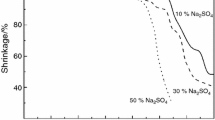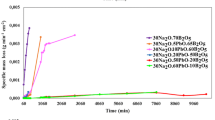Abstract
The liquidus temperature (T L) of rare earth (RE) was determined for alumino-borosilicate glasses for treating americium and curium that have been studied previously. Their work covers a wide range of glass composition with various crystalline phases as primary phase. Present work is aimed at understanding the effect of glass composition on TL for waste glasses designed for vitrifying RE oxides wastes. In a sufficiently narrow composition region, this effect can be represented by a first-order model fitted measured TL versus composition data. Test glasses were formulated by varying of component fractions one-at-a-time. The glasses contained SiO2, B2O3, and Al2O3 as glass formers and Nd2O3 with CeO2 as simulated RE waste. Twenty glasses were made to investigate crystallization as a function of temperature and glass composition. The primary crystalline phase was Ce-borosilicate (Ce3BSi2O10), secondary phases were Al-containing crystals (Al2O3 and Al10Si2O19), and crystalline CeO2. A first-order model was fitted to crystal fraction versus glass composition data. Generally, SiO2 and B2O3 tend to suppress crystallization, Al2O3 has little effect, and, as expected, RE components (Nd2O3 and CeO2) promote it. The correlation coefficient, R2, was 0.89 for the primary crystalline phase TL as a linear function of composition.
Similar content being viewed by others
References
D. Peeler, T.B. Edwards, I.A. Reamer, J.D. Vienna, D.E. Smith, M.J. Schweiger, B.J. Riley, J.V. Crum. WSRC-TR-99–00055, Rev. 0, Westinghouse Savannah River Company, Savannah River Site, Aiken, South Carolina (1999).
B.J. Riley, J.D. Vienna, M.J. Schweiger, D.K. Peeler and I.A. Reamer. In Proceedings of the Scientific Basis for Nuclear Waste Management XXIII, 608, pp 677–682, Materials Research Society, Warrendale, PA (1999).
J.-H. Yoo, C.-S. Seo, E.-H. Kim & H. S. Lee. Nuclear Engineering and Technology 40 (7): 581–592 (2008).
P. Hrma, B.J. Riley, J.V. Crum, J. Matyas. J. Non-Cryst. Solids. 384, 32–40 (2014).
ASTM C1720-11, Standard Test Method for Determining Liquidus Temperature of Immobilized Waste Glasses and Simulated Waste Glasses, ASTM Int., West Conshohocken, PA (2011).
B.J. Riley, P.R. Hrma, J.D. Vienna, M.J. Schweiger, C.P. Rodriguez, J.V. Crum, J.B. Lang, J.C. Marra, F.C. Johnson, D.K. Peeler, C. Leonelli, A.M. Ferrari, I. Lancellotti, J.-L. Dussossoy, R.J. Hand, J.M. Schofield, A.J. Connelly, R. Short, and M.T. Harrison, Int. J. Appl. Glass Sci. 2 (4) 321–333 (2011).
Author information
Authors and Affiliations
Rights and permissions
About this article
Cite this article
Mohd Fadzil, S., Hrma, P. The Effect of Glass Composition Containing RE Oxide Waste Glass on Liquidus Temperature. MRS Advances 1, 4221–4225 (2016). https://doi.org/10.1557/adv.2017.212
Published:
Issue Date:
DOI: https://doi.org/10.1557/adv.2017.212




